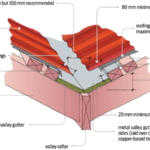- Assess your needs: Decide what type of gutters will work best for your home and your budget.
- Consider your climate: In areas with a lot of rainfall, you’ll need gutters that can handle heavy runoff.
- Choose a material: Gutters are available in a variety of materials, including aluminum, vinyl, and steel.
- Find a contractor: Once you’ve decided on the type of gutters you need, find a reputable contractor to install them.
- Get a written estimate: Make sure to get a written estimate from your contractor before work begins.
What is the rule of thumb for gutters?
The rule of thumb for gutters is that they should be cleaned out at least twice a year. This ensures that they are able to catch and funnel away rainwater effectively, preventing water damage to your home.
Should you put gutters all around your house?
There are a few things to consider when deciding if you should put gutters all around your house. One is the climate. If you live in an area with a lot of rainfall, gutters can help protect your home from water damage. Even if you don’t get a lot of rain, gutters can still help keep your house clean by keeping leaves and other debris from accumulating on your roof and around your foundation.
Another thing to consider is the type of roof you have. If your roof is sloped, gutters can help prevent water from pooling on your roof and causing leaks. They can also help keep your foundation from eroding by channeling water away from your house.
If you decide to install gutters, you’ll need to decide what material to use. Gutters are typically made from aluminum, vinyl, or steel. Each has its own advantages and disadvantages. Aluminum gutters are lightweight and easy to install, but they can dent easily and may need to be replaced more often than other types of gutters. Vinyl gutters are also lightweight and easy to install, but they’re not as durable as aluminum gutters and can become brittle in cold weather. Steel gutters are the most durable, but they’re also the heaviest and most expensive.
No matter what material you choose, make sure the gutters are installed properly so they can do their job. If they’re not installed correctly, they can actually do more harm than good.
What are some common mistakes that people make when installing gutters?
One of the most common mistakes that people make when installing gutters is not taking proper measurements. This can lead to gutters that are either too small or too large for the space, which can cause problems with both function and aesthetics.
Another common mistake is not installing a gutter guard or leaf guard of some kind. This can allow leaves and other debris to clog up the gutters, which can lead to water damage and other problems.
Finally, some people fail to properly secure the gutters to the roof or fascia. This can allow the gutters to come loose and possibly fall, which can cause serious damage.
How much does it cost to install 20 feet of gutters?
The cost of installing 20 feet of gutters can vary depending on the type of gutters you choose and the company you hire. Expect to pay anywhere from $200 to $1,000 for the job.
If you’re looking to install gutters on your own, you can expect to pay around $100 for the materials. This includes the gutters, hangers, and downspouts. You’ll also need to factor in the cost of your time and any tools you need to rent.
Hiring a professional to install your gutters will obviously cost more, but it’s worth it for the peace of mind. A professional gutter installer will have the experience and know-how to get the job done quickly and correctly. They’ll also be able to spot any potential problems with your gutters and make recommendations for repairs or replacements.
When hiring a professional, get at least three estimates to ensure you’re getting the best price. Be sure to ask about any warranties or guarantees that come with the installation.
Installing gutters may not be the most exciting home improvement project, but it’s an important one. By taking the time to do your research and choose the best option for your home, you can rest assured that your gutters will be installed correctly and will last for years to come.
Do gutters go on before or after siding?
The answer may depend on the climate, the type of siding, and the type of gutter, but in general, it is best to install gutters before siding. This will help to ensure that the gutters are properly installed and will not be damaged by the siding.
How do you know if you need 5 or 6 inch gutters?
The size of the gutters you need depends on the size and slope of your roof. If you have a small roof or a shallow slope, you can get away with 5 inch gutters. However, if you have a large roof or a steep slope, you will need 6 inch gutters to prevent rainwater from overflowing.
How do you estimate gutters?
- Start by measuring the length and width of the house.
- Then, calculate the square footage of the house to get an estimate of the size of the gutters you’ll need.
- Next, consider the type of gutters you want and the materials they’re made from.
- Finally, get an estimate from a professional gutter installer.
Bottom Line
There are a few things to consider when deciding where to install your gutters. The first is the slope of your roof. You’ll want to make sure the gutters are installed at a slope that will allow water to run off easily. The second is the type of gutters you’ll be using. If you’re using plastic gutters, you’ll want to make sure they’re installed securely so they don’t blow away in a storm. Finally, you’ll want to consider the height of your gutters. If you have a two-story house, you’ll want to make sure the gutters are installed high enough so that water doesn’t splash onto your windows.
















